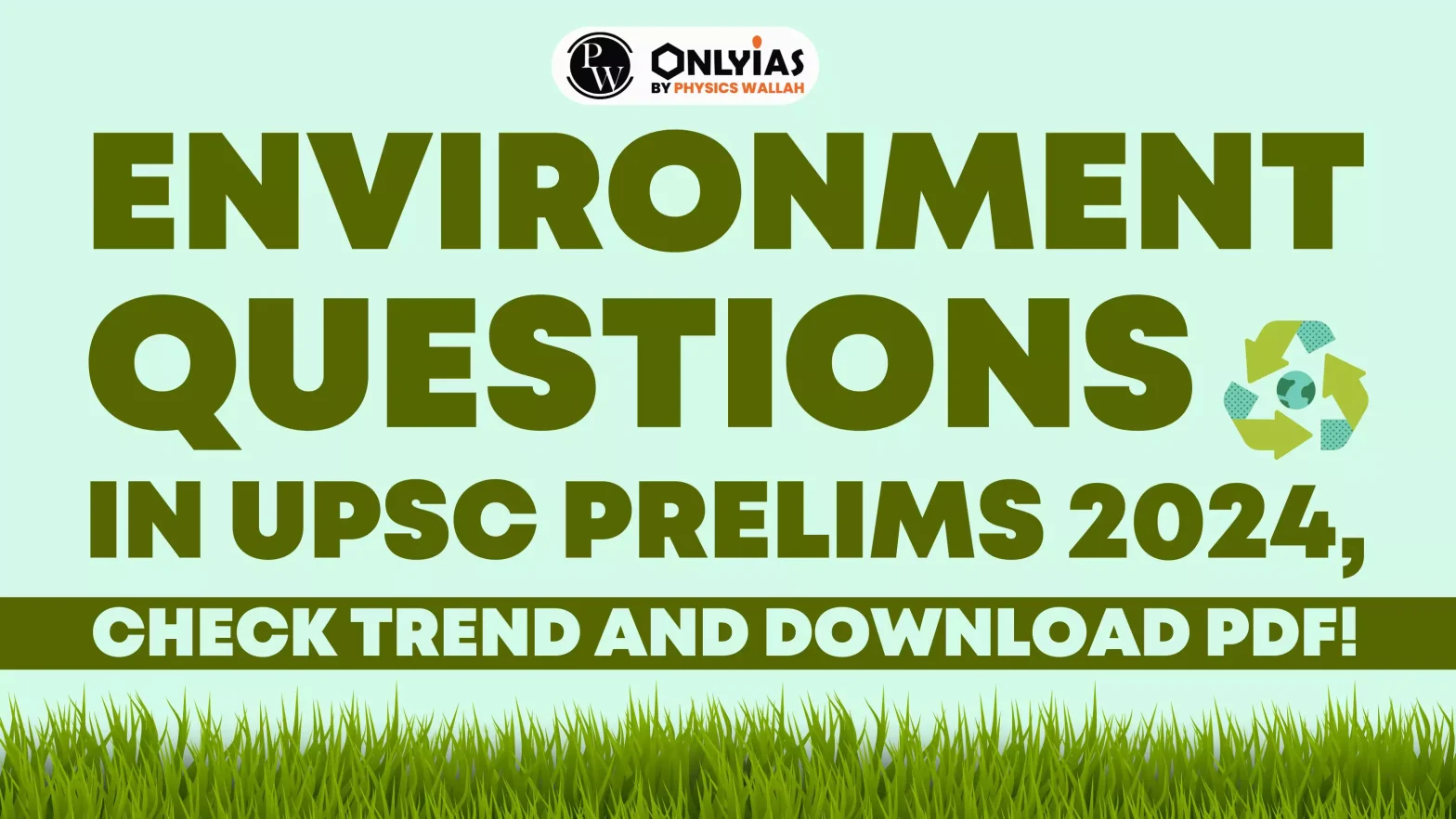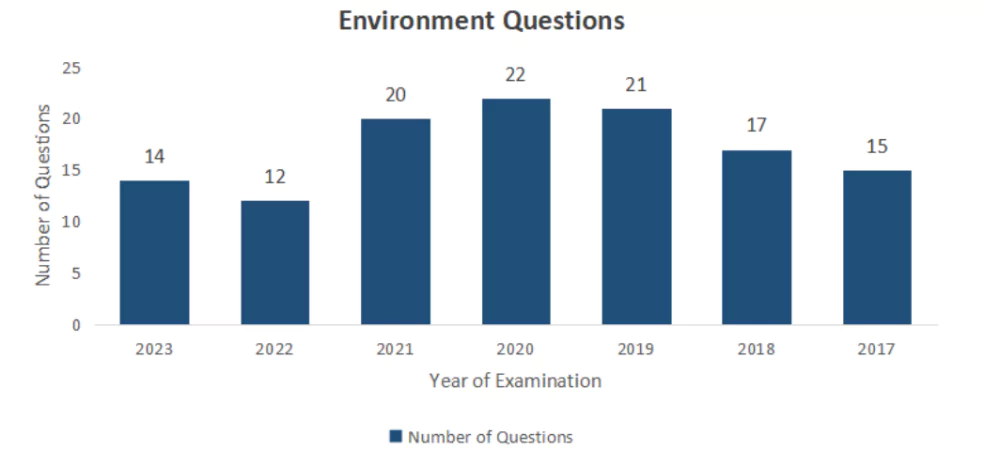Environment Questions in UPSC prelims 2024 will give an opportunity for aspirants to streamline their preparation. Check out more about Environment Questions in UPSC prelims.

Environment questions in UPSC prelims is a combination of static and dynamic concepts. There are some questions asked directly from current affairs while others are based on static concepts. Candidates aiming to score good marks in prelims cannot ignore environment questions in UPSC prelims as the weightage of the subject is increasing over the years.
| Download UPSC Prelims Question Paper 2024 | |
| UPSC Prelims GS Paper I | Download Link |
| UPSC Prelims GS Paper II CSAT | Question Paper Download Link |
| Answer Key 2024 | GS Paper (01) Answer Key 2024 CSAT Paper Answer Key 2024 |
| DetaIled Answer Key 2024 | GS Paper (01) Answer Key 2024 CSAT Paper Answer Key 2024 |
On an average, about 18-22 environment questions in UPSC prelims are asked. These questions range from simple facts about species to environmental concepts. Candidates can identify the important themes of the environment subject after completely reading this article.
Let us have a look at the Environment Questions in UPSC Prelims 2024, along with the trends of the themes from the Previous years questions. The Trend Analysis of the previous years Environment Questions in UPSC Prelims is also given here.
Environment Questions in UPSC Prelims 2024 can be anticipated a little by seeing the Environment Questions of UPSC Prelims 2023 and other previous years. The number of environment questions in UPSC prelims was 14, which was slightly lower than previous years. Candidates must remember that UPSC may change this trend and higher number of questions in prelims 2024. The questions asked from environment in prelims 2023 is as follows:
Q1. Consider the following statements:
Which of the statements given above is/are correct?
(a) 1 only
(b) 2 only
(c) Both 1 and 2
(d) Neither 1 nor 2
Answer: (c)
Q2. ‘Invasive Species Specialist Group’ (that develops Global Invasive Species Database) belongs to which one of the following organizations?
(a) The International Union for Conservation of Nature
(b) The United Nations Environment Programme
(c) The United Nations World Commission for Environment and Development
(d) The World Wide Fund for Nature
Answer: (c)
Q3. Consider the following statements:
Once the Central Government notifies an area as a ‘Community Reserve’
How many of the above statements are correct?
(a) Only one
(b) Only two
(c) Only three
(d) All four
Answer: (c)
Q4. Consider the following infrastructure sectors:
On how many of the above does the UNOPS Sustainable Investments in Infrastructure and Innovation (S3i) initiative focus on its investments?
(a) Only one
(b) Only two
(c) Only three
(d) All four
Answer: (c)
Q5. Consider the following statements:
Statement I: Marsupials are not naturally found in India.
Statement II: Marsupials can thrive only in montane grasslands with no predators.
Which one of the following is correct in respect of the above statements?
(a) Both Statement I and Statement II are correct and Statement II is the correct explanation for Statement I
(b) Both Statement I and Statement II are correct and Statement II is not the correct explanation for Statement I
(c) Statement I is correct Statement II is incorrect
(d) Statement I is incorrect but Statement II is correct
Answer: (c)
Q6. Which of the following organisms perform a waggle dance for others of their kin to indicate the direction and the distance to a source of their food?
(a) Butterflies
(b) Dragonflies
(c) Honey Bees
(d) Wasps
Answer: (c)
Q7. Consider the following statements:
How many of the above statements are correct?
(a) Only one
(b) Only two
(c) Only three
(d) All four
Answer: (d)
Q8. Which one of the following makes a tool with a stick to scrape insects from a hole in a tree or a log of wood?
(a) Fishing cat
(b) Orangutan
(c) Otter
(d) Sloth bear
Answer: (b)
Q9. Consider the following statements regarding the Indian squirrels:
How many of the above statements are correct?
(a) Only one
(b) Only two
(c) All three
(d) None
Answer: (a)
Q10. Consider the following fauna:
How many of the above are generally nocturnal or most active after sunset?
(a) Only one
(b) Only two
(c) All three
(d) None
Answer: (b)
Q11. Consider the following:
In the making of how many of the above are hydrofluorocbons used?
(a) Only one
(b) Only two
(c) Only three
(d) All four
Answer: (c)
Q12. Consider the following activities:
How many of the above activities are often considered and discussed for carbon capture and sequestration?
(a) Only one
(b) Only two
(c) All three
(d) None
Answer: (c)
Q13. Consider the following statements:
Which of the statements given above is/are correct?
(a) 1 only
(b) 2 only
(c) Both 1 and 2
(d) Neither 1 nor 2
Answer: (a)
Q14: Consider the following statements regarding mercury pollution:
How many of the above statements are correct?
(a) Only one
(b) Only two
(c) All three
(d) None
Answer: (c)

The trend of Environment Questions in UPSC Prelims 2024 can be understood by analysing the Environment Questions in UPSC Prelims from previous years. On an average, UPSC has been asking 15-20 questions every year from the environment syllabus. Some of these questions may overlap with IR and Geography. This is the reason for a slight decrease in the past couple of years. The number of environment questions in UPSC prelims in the last few years is as below:
| Year | Number of Questions |
| 2023 | 14 |
| 2022 | 12 |
| 2021 | 20 |
| 2020 | 22 |
| 2019 | 21 |
| 2018 | 17 |
| 2017 | 15 |

Every candidate needs to understand the Environment Questions in UPSC Prelims in the previous years to prepare the Environment Questions in UPSC Prelims 2024. Candidates preparing for environment subject have to modify their approach to score more marks in the environment section of UPSC prelims. following tips can be followed to excel in environment questions in UPSC prelims:
Repeated themes act as a direction for candidates to streamline their preparation. Identifying repeated themes will enable candidates to give additional focus to those topics that have a high chance of getting repeated. Following table contains a list of most repeated themes in UPSC prelims from environment topic.
| Themes | Significance |
| Fundamentals of Environment and Ecology | 1-2 questions |
| Pollution | 2-3 questions related to pollution of air, water, soil etc. |
| Conservation of Environment | 1-2 questions related to flora and fauna |
| Species in News | 2-3 questions related to unique behavior of plant and animal species. |
| Species Conservation | 1-3 questions related to wildlife sanctuary, national parks etc. |
| International Agreements | 1-2 questions on UNFCCC, Montreal Protocol etc. |
| Environmental Policies in India | 1-2 questions on related acts. |
Repeated themes and the nature of questions from these themes can play a vital role in UPSC prelims preparation. Candidates can check the environment questions in UPSC prelims asked from repeated themes.
Environmental Policies in India
Q) The Genetic Engineering Appraisal Committee is constituted under the: (2015)
(a) Food Safety and Standards Act, 2006
(b) Geographical Indications of Goods (Registration and Protection) Act, 1999
(c) Environment (Protection) Act, 1986
(d) Wildlife (Protection) Act, 1972
International Agreements
Q. If a wetland of international importance is brought under the ‘Montreux Record’, what does it imply?
(a) Changes in ecological character have occurred, are occurring, or are likely to occur in the wetland as a result of human interference.
(b) The country in which the wetland is located should enact a law to prohibit any human activity within five kilometres from the edge of the wetland.
(c) The survival of the wetland depends on the cultural practices and traditions of certain communities living in its vicinity and therefore the cultural diversity therein should not be destroyed.
(d) It is given the status of ‘World Heritage Site’
National Parks/Wildlife Sanctuary
Q) Which one of the following National Parks has a climate that varies from tropical to subtropical, temperate, and arctic? (2015)
(a) Khangchendzonga National Park
(b) Nanda Devi National Park
(c) Neora Valley National Park
(d) Namdapha National Park
Conservation of Environment
Q) The most important strategy for the conservation of biodiversity together with traditional human life is the establishment of: (2014)
(a) Biosphere reserves
(b) Botanical gardens
(c) National parks
(d) Wildlife sanctuaries
Q) With reference to ‘Red Sanders’, sometimes seen in the news, consider the following statements: (2016)
It is a tree species found in a part of South India.
It is one of the most important trees in the tropical rainforest areas of South India.
Which of the statements given above is/are correct?
(a) 1 only
(b) 2 only
(c) Both 1 and 2
(d) Neither 1 nor 2
Q) Photochemical smog is a resultant of the reaction among (2013)
(a) NO2, O3, and peroxyacetyl nitrate in the presence of sunlight
(b) CO, O2, and peroxyacetyl nitrate in the presence of sunlight
(c) CO, CO2 and NO2 at low temperature
(d) High concentration of NO2, O3 and CO in the evening
Fundamental of Environment and Ecology
Q) Which one of the following terms describes not only the physical space occupied by an organism but also its functional role in the community of organisms? (2013)
(a) Ecotone
(b) Ecological niche
(c) Habitat
(d) Home range
Join top courses from Physics Wallah to realize your dream of becoming an IAS Officer! Enroll now!
Newspapers such as The Hindu and The Indian Express, magazines such as Down to Earth are the best sources for environment topic.
Candidates have to analyse PYQs from the last few years to identify themes that may be asked in the exam.
No. UPSC may ask questions from the same theme but it does not repeat the same questions in prelims. Candidates should analyse the previous year Environment Questions in UPSC Prelims to understand the trend only. The questions are not repeated as it is.
Based on the trends from the past few years, UPSC can ask about 18-20 questions from environment topic. Although the number of Environment Questions in UPSC Prelims may vary according to the difficulty of the Exam.
Yes. Many questions are asked directly from current affairs, which are covered extensively by newspapers.

<div class="new-fform">
</div>